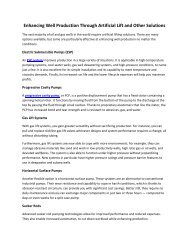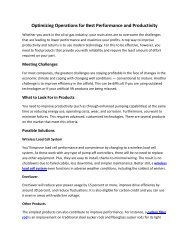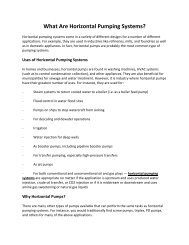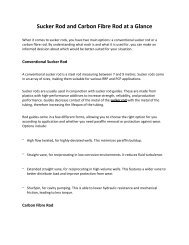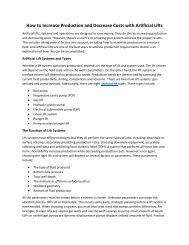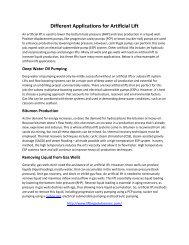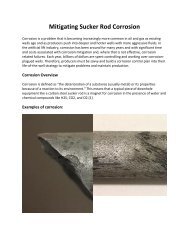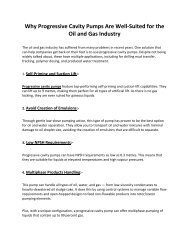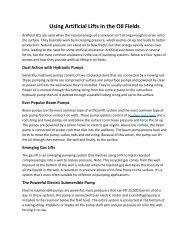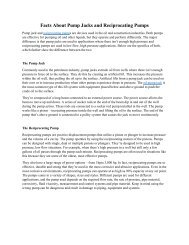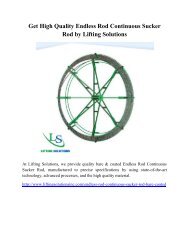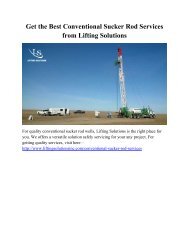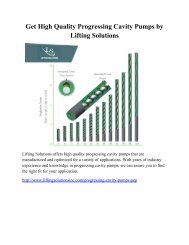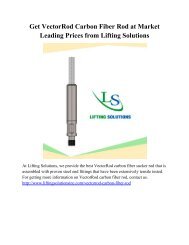Using Artificial Lifts to Optimize Your Production
Get VectorRod carbon fiber sucker rod from Lifting Solutions for achieving your production goals when pumping to deeper depths. The carbon fiber used in this product is light in weight and is assembled with proven steel end fittings.
Get VectorRod carbon fiber sucker rod from Lifting Solutions for achieving your production goals when pumping to deeper depths. The carbon fiber used in this product is light in weight and is assembled with proven steel end fittings.
You also want an ePaper? Increase the reach of your titles
YUMPU automatically turns print PDFs into web optimized ePapers that Google loves.
<strong>Using</strong> <strong>Artificial</strong> <strong>Lifts</strong> <strong>to</strong> <strong>Optimize</strong> <strong>Your</strong> <strong>Production</strong><br />
When it comes <strong>to</strong> artificial lift pump operations, opera<strong>to</strong>rs have two priorities. One,<br />
they want <strong>to</strong> increase their production. Two, they want <strong>to</strong> bring down the costs of<br />
doing so. In order <strong>to</strong> achieve both, there is a need <strong>to</strong> implement proper planning as<br />
a way of avoiding poor performance.<br />
Dealing with mature fields will often be met with challenges related <strong>to</strong> field<br />
productivity, and the artificial lift is a method that can be implemented <strong>to</strong> establish<br />
full recovery for fields or wells. Because there are many types of artificial lift<br />
systems, it is important <strong>to</strong> choose the best method for the job.<br />
The different types of artificial lift systems can be separated in<strong>to</strong> two categories:<br />
pump-assisted process and gas-assisted process. Positive displacement pumps (or<br />
PDPs) under the pump-assisted process include carbon fiber rod pumps,<br />
progressive cavity pumps and others have fixed quantities of fluids in a cavity and<br />
forced <strong>to</strong> move in a designed direction. Meanwhile, electrical submersible pumps<br />
or ESPs allow for unfixed quantities of fluids for displacement. With gas lifts, the<br />
injected gas lessens the density of reservoir fluid and thus decreases hydrostatic<br />
pressure, letting the produced fluid flow right out <strong>to</strong> its surface.<br />
With the differences, it is important <strong>to</strong> understand that optimizing production using<br />
artificial lifts will tap on the following things:<br />
- Accurate data collection<br />
- Correct predictions of rates of production<br />
- Downhole volumes<br />
- TDHs, or <strong>to</strong>tal dynamic head determination<br />
- Right selection of surface and downhole equipment<br />
The different types of artificial lift methods will require considerations of<br />
applications for depth as well as temperature. These two things are considered as<br />
limiting fac<strong>to</strong>rs for different PCP applications, though it is capable of lifting denser<br />
fluids. What one needs <strong>to</strong> take note of is <strong>to</strong> fully understand how each of the<br />
characteristics of artificial lifts will impact performance when on the job.
As one will see, there is interdependence between production optimization and cost<br />
reduction for artificial lift systems. It is only through proper planning of a strategic<br />
design that is fully grounded on the individual well characteristics with the<br />
practical operational capabilities of a lift system. Choosing which is the most ideal<br />
artificial lift system for wells will also involve fac<strong>to</strong>rs such as bot<strong>to</strong>m hole<br />
pressure, amount and type of fluid that will be produced, wellbore geometry,<br />
surface location (offshore or onshore), and the <strong>to</strong>tal depth of the well. Planning<br />
carefully and utilizing all the information about all the known fac<strong>to</strong>rs will<br />
definitely yield better results than the usual habit of doing things the “usual way”<br />
even when there are clear opportunities for innovation.




